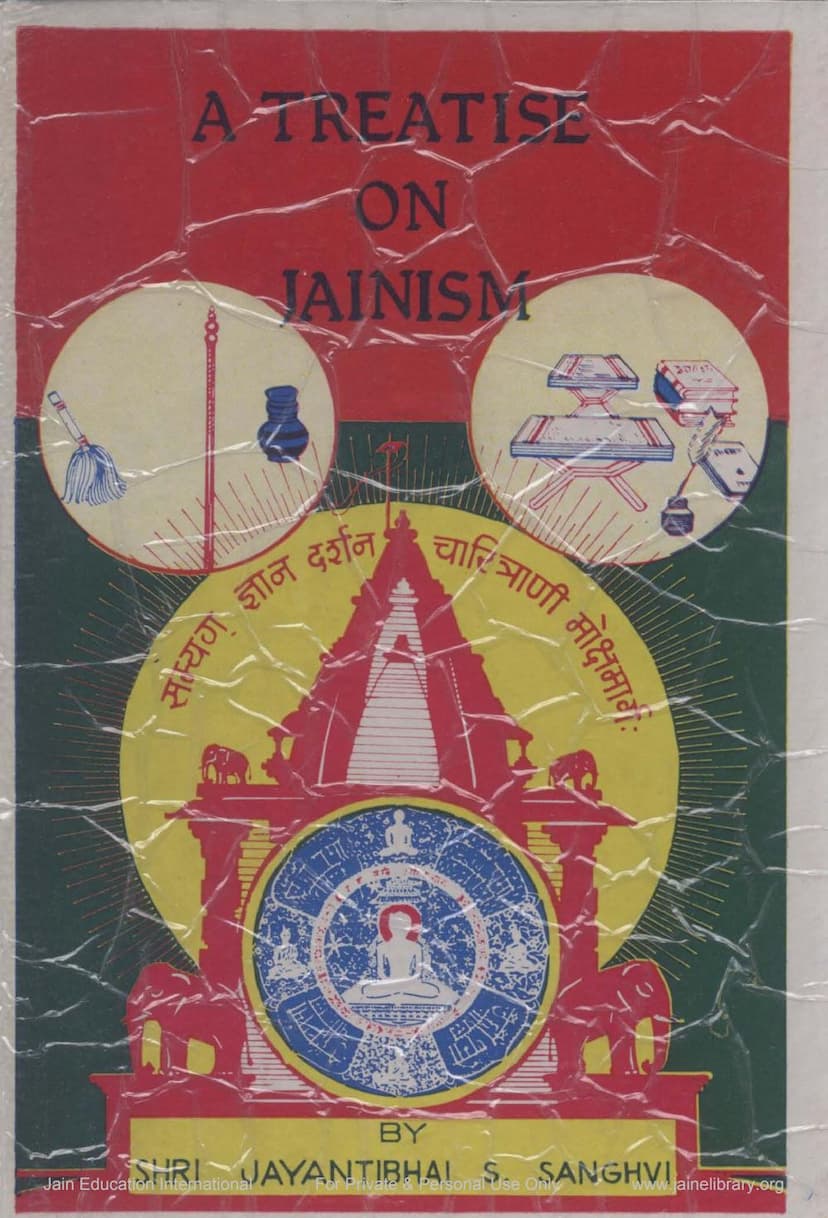Treatise On Jainism
Added to library: September 2, 2025

Summary
Here's a comprehensive summary of the provided Jain text, "A Treatise on Jainism" by Jayantibhai S. Sanghvi, based on the provided pages:
Book Overview and Core Philosophy:
"A Treatise on Jainism" by Jayantibhai S. Sanghvi is a concise yet comprehensive guide to the fundamental principles and practices of Jainism. The book aims to present Jainism in a simple language, making it accessible to a wide audience, including students of Jain philosophy, general readers of Indian philosophy, and Western students. The author, Jayantibhai S. Sanghvi, was a dedicated seeker of truth who developed this work from his intensive study of Jain scriptures.
The central tenet of Jainism, as presented in the book, is Ahimsa Parmo Dharma (Non-violence is the paramount religion). This principle extends to all living beings, emphasizing love and protection for all, recognizing the potential divinity and the desire for happiness in every soul.
The Three Jewels (Ratna Traya):
The path to liberation (Moksha) in Jainism is built upon the foundation of the Three Jewels:
-
Samyak Darshan (Right Belief/Faith): This is the unshakeable conviction in the real nature of the soul, non-soul, and the seven principles of Jainism. It involves understanding the fundamental truths of existence logically and without doubt, superstition, or envy. The book details eight pillars or qualities that constitute Right Belief, including freedom from doubt, desire, disgust, superstition, fault-finding, and the presence of steadfastness, affection for co-religionists, and propagation of the faith.
-
Samyak Jnana (Right Knowledge): This is the correct understanding of the seven principles, acquired through diligent study of scriptures. It must be free from doubt, perversity, and indefiniteness. The book outlines eight pillars of Right Knowledge, emphasizing correct reading, understanding of meaning, proper pronunciation, adherence to time, reverence, proper behavior, zeal, and the non-concealment of knowledge.
-
Samyak Charitra (Right Conduct): This is the practical application of Right Belief and Right Knowledge, aimed at freedom from attachment, aversion, and impure thought activities to achieve equanimity. Right Conduct is the most crucial for achieving Moksha, as it leads to the destruction of all karmic bondage. It is categorized into the complete conduct of saints (Mahavrata) and the partial discipline of lay followers (Anuvrata). The five main vows are:
- Ahimsa (Non-violence): Refraining from injury to any living being.
- Satya (Truth): Refraining from falsehood.
- Asteya (Non-stealing): Refraining from appropriating what is not given.
- Brahmacharya (Chastity): Sexual purity.
- Aparigraha (Non-attachment): Limiting one's possessions and attachments, both internal and external.
The book also details supplementary vows (Sheelas) and daily duties for householders, as well as the rigorous observances of saints.
Key Jain Concepts Explained:
- Jinas and Tirthankaras: The text explains that Jinas are those who have conquered internal enemies and impurities. Tirthankaras are those who appear periodically to re-establish and propagate the Jain teachings. Lord Mahavir is identified as the last of the 24 Tirthankaras, but not the founder of the religion, which is considered eternal.
- The Theory of Karma (Law of Causation): Jainism posits a unique theory of Karma as subtle matter that flows into and binds the soul. This bondage, driven by attachment (Raga) and hatred (Dwesha), determines the soul's experiences and rebirths. The book elaborates on the eight main types of Karmas (Jnanavarneeya, Darshanavarneeya, Vedneeya, Mohaneeya, Ayushya, Nama, Gotra, Antaraya) and their numerous sub-classes, explaining how they obscure the soul's true nature and lead to its transmigration.
- Six Dravyas (Substances): The universe is understood to consist of six eternal, fundamental substances: Jiva (Soul), Ajiva (Non-soul), Pudgala (Matter), Dharma (Principle of Motion), Adharma (Principle of Rest), Kala (Time), and Akasha (Space). The book describes their attributes and modifications.
- Seven Tattvas (Principles): These are the core principles for understanding existence and the path to liberation: Jiva (Soul), Ajiva (Non-soul), Asrava (Inflow of Karmas), Bandha (Bondage of Karmas), Samvara (Stoppage of Inflow), Nirjara (Shedding of Karmas), and Moksha (Liberation).
- Fourteen Gunasthanas (Spiritual Stages): The soul's journey towards liberation is depicted through 14 stages of spiritual progress, starting from delusion (Mithyatva) and progressing through stages of partial vows, perfect vows, and finally to states of soul-consciousness free from delusion and activity.
- Syadvada and Anekantavada: The book highlights Syadvada (the doctrine of conditional predication) and Anekantavada (the doctrine of manifold aspects) as the core logic of Jain philosophy. These principles emphasize that truth is multifaceted and can be understood from different viewpoints, illustrating this with parables like the "other side of the shield" and the "blind men and the elephant."
Purpose and Dedication:
The treatise is dedicated to the author's parents, who were deeply influenced by Jain philosophy and practice. It was compiled from the author's notes and aims to make Jain teachings accessible and beneficial to all seekers of truth. The book serves as a valuable resource for understanding the intricate philosophy and ethical framework of Jainism.
In essence, "A Treatise on Jainism" provides a structured and clear exposition of Jain doctrine, emphasizing the transformative power of Right Belief, Right Knowledge, and Right Conduct in achieving the ultimate goal of liberation.